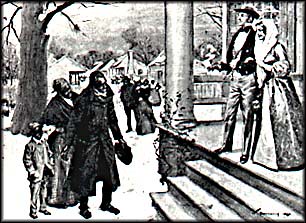Christmas has been called the most wonderful time of the year. It is a time for family to come together and create magical memories. Memories that are full of fun, food, and festivities that are often passed down through generations. While this time of the year is marked with joy, love, and filled with lots of holiday cheer, for many slaves the Christmas holiday was bittersweet . It is difficult to imagine celebrating anything while living in bondage and a constant state of fear but slaves did so for more than 200 years. With a constant threat to daily life, how did they spend the holiday season? Did Christmas ease the burden placed on them to produce for their owners? Did they get time off? Were they allowed to celebrate the holiday? So what exactly did Christmas in bondage look like?
Christmas on slave plantations

Ironically, Christmas on slave plantations was one of the few times of the year that slaves looked forward to. They enjoyed time off from daily labor tasks, a sense of camaraderie with plantation owners, fun, food, and festivities. Being that the holiday was also a time where one could replenish, many took advantage of this time to seek respite and rest their tired bodies, reconcile with loved ones owned by other slave owners, and spend time with their families. Christmas was observed across many plantations and they were given gifts and the opportunity to celebrate alongside slave-owners in holiday festivities. Many were allowed to sell their own items and keep the profit and given gifts that ranged from handkerchiefs and scarves to molasses and flour. Because these were items that were seldom given, many of them indulged in food that they were unable to have throughout the remaining parts of the year. Dutch ovens were given to them by their masters; and with the flour and other seldomly used ingredients received on Christmas day, they would make breads, cakes, pies, and biscuits. Christmas dinner consisted of everything from roasted possum and ham to pigs feet and barbecued hogs. Side dishes included greens, ashcakes (a type of bread wrapped in cabbage leaves and baked in hot ashes), sweet potatoes, salad greens, and squash. But, getting a break during Christmas was not guaranteed. Not all slaves were able to enjoy time off because many plantation owners hosted large lavish parties that actually increased the work of household slaves. Also, anyone who was disobedient or had upset their master was also denied time off as well.

As such, those who were able to participate in the holiday celebrations would be given permission to select a yule log to burn. Careful attention was placed on the selection of a log because once burned, the holiday was over. Most time off would last anywhere from two to seven days. During the Christmas holiday, many slaves engaged in rituals during this time of year. Rituals such as “Christmas gift†and JonKonnu were popular across many parts of the South. On Christmas day, they were allowed to ask any white person they saw for a small gift as long as they did not address them first. All they had to say when approaching the white person was, “Christmas gift.†In Jonkonnu, slave men would dress up in masks and costumes and masquerade around town going from house to house playing music and dancing while collecting small gifts. The Christmas holiday also gave them the opportunity to travel and visit family members who may have been separated or sold the previous season to another plantation owner. This was also an opportune time to visit with other slaves and engage in romantic encounters that often lead to marriage.

While many slaves enjoyed the delights that the Christmas holiday ushered in, there were plenty who saw this as an opportunity to escape from their oppressors and seek freedom as plantation owners were preoccupied with the festivities of the season. There are many recorded accounts of slaves utilizing travel passes that they were given upon request from the slave to go visit family. Slave rebellions typically increased around Christmas due to owners traveling, entertaining guests, and the lax schedule that was often instituted to during the holiday.
Christmas was more than just a joyous time of year to celebrate and give gifts; it was a double-edged sword. On one hand it cut into the daily rigors and down-trodden existence of slave life, but it also served as a sinister way to appease those who may otherwise rebel and seek freedom. According to Frederick Douglass, who himself was born into slavery, Christmas was just another oppressive tool used by slave owners to reinforce their control over the slaves and break up solidarity, ease the burden of familial separation and exert control. While it was a way to break up the hardships of slavery itself, in short, it was a tool used to control slaves by appealing to the psychological need to reunite with families, rest, and socialize.
Sources:
Slave gifts: https://docsouth.unc.edu/highlights/holidays.html
Ashcakes: https://civilwartalk.com/threads/food-of-the-enslaved-series.137715/
Jonkonnu: https://docsouth.unc.edu/commland/features/essays/johnkonnu-1/
Travel passes: https://docsouth.unc.edu/highlights/holidays.html
Frederick Douglass: https://werehistory.org/christmas-on-plantation/


